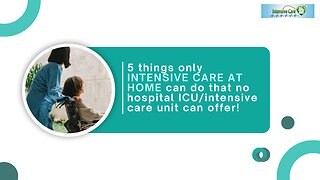Premium Only Content

Why Cerebral Palsy Adults&Children on BIPAP At Home Need 24/7 Critical Care Nurses (Evidence Based)!
Why Cerebral Palsy Adults&Children on BIPAP At Home Need 24/7 Critical Care Nurses (Evidence Based)!
Book your free 15-minute phone consultation here
http://intensivecarehotline.com/scheduling-appointment/
Call directly 24/7
+1 415-915-0090 USA/Canada
+44 118 324 3018 UK
+6141 094 2230 Australia
Email support@intensivecarehotline.com
Get 1:1 consulting and advocacy
1:1 phone counselling
http://intensivecarehotline.com/one-on-one-counselling/
Become a member for families of critically ill Patients in Intensive Care
https://intensivecarehotline.com/intensivecaresupport-org-membership/
Immediate action steps http://intensivecarehotline.com/take-control-take-charge/immediate-action-steps/
https://intensivecareathome.com
And if you need a medical record review, click on the link and we can help you with reviewing your loved one’s medical records while they’re in ICU.
https://intensivecarehotline.thrivecart.com/review-of-medical-records/
Facebook Page: https://www.facebook.com/ICUhotline
Twitter: https://twitter.com/icuhotline
Song: Jarico - Island Music
supported by@FreeBackgroundMusicForCreators
#BackgroundMusicWithoutLimitations
https://bit.ly/2XoXFnb
#icu
#intensivecare
#criticalcare
Hi, it’s Patrik Hutzel from intensivecareathome.com where we provide tailor-made solutions for long-term ventilated adults and children with tracheostomies at home and where we also provide tailor-made solutions for hospitals and intensive care units at home whilst providing quality care for long-term ventilated adults and children with tracheostomies at home, otherwise medically complex clients at home adults and children, which includes BIPAP (Bilevel Positive Airway Pressure), CPAP (Continuous Positive Airway Pressure) at home, home tracheostomy care for adults and children that are not ventilated, Home TPN (Total Parenteral Nutrition), home IV potassium infusions, home IV magnesium infusions as well as home IV antibiotics. We’re also providing port management, central line management, PICC (Peripherally Inserted Central Catheter) line management, as well as Hickman’s line management and we also provide palliative care at home.
We have also sent, and we continue to send our critical care nurses into the home for emergency department bypass services. We have done so successfully for the Western Sydney Local Area Health District, their in-touch program.
Now, today I want to talk more about why especially cerebral palsy children need BIPAP sometimes at home and if they do need BIPAP, why they need critical care nurses 24 hours a day. I can give you some real-world examples from some of our clients, but also from the cerebral palsy website.
A lot of cerebral palsy children end up with scoliosis and therefore their respiratory health is very compromised and breathing problems may arise, and a lot of the clients that we’ve worked with over the years with cerebral palsy end up on BIPAP or on CPAP, predominantly on BIPAP. But several things contribute to the need for BIPAP including aspiration often, which is caused by the weakness or spasticity in the digestive tract muscles, may also cause the breathing problems and the aspiration. Also, gastroesophageal reflux, which often ends up for those children having a fundoplication.
Pneumonia is often caused because there’s an unsatisfactory cough and respiratory tract infections are often caused because those kids cannot clear their secretions, and those infections can readily develop into a pneumonia. So how can that be managed? Once again, it can be managed with deep suctioning. For example, some kids need a nasopharyngeal airway, but that’s not often enough, deep suctioning is not often enough. The tidal volumes when someone is on BIPAP or CPAP can be quite small. With the small tidal volumes (the volumes that are going into the lungs), that’s the only way really that adequate ventilation is established and maintained.
I’ll give you another example. One of our clients who’s a child at home on BIPAP for cerebral palsy. The client has a Glasgow coma scale of about 7 out of 15, which means the client is neurologically very compromised and therefore, also has issues clearing the airway. So, a nasopharyngeal airway is regularly used to clear the airway, that means a nasopharyngeal airway is inserted into the nose and then deep suctioning is often applied to clear the secretions.
Continue reading at: https://intensivecareathome.com/why-cerebral-palsy-adults-children-on-bipap-bilevel-positive-airway-pressure-at-home-need-24-7-critical-care-nurses-evidence-based/
-
 12:15
12:15
Intensive Care at Home
15 days ago5 Things Only IN TENSIVE CARE AT HOME Can Do that No Hospital ICU/ Intensive Care Unit Can Offer!
42 -
 1:15:22
1:15:22
Donald Trump Jr.
7 hours agoDelivering the Day One Agenda: No More Neocons, Plus Interview with Charlie Kirk | TRIGGERED Ep.190
134K158 -
 LIVE
LIVE
The StoneZONE with Roger Stone
1 hour agoTrump Sends Stefanik to UN, Sticker Mule CEO Anthony Constantino to Seek Her Seat? The StoneZONE
1,838 watching -
 2:20:17
2:20:17
WeAreChange
3 hours agoPANIC In "Dystopian Hellscape" DC! Kamala Can Still Be PRESIDENT
38.9K4 -
 39:57
39:57
Kimberly Guilfoyle
7 hours agoBreaking News: President Trump’s Latest Hires, Plus the Meaning of Veterans Day | Ep. 173
111K48 -
 1:08:23
1:08:23
Sarah Westall
2 hours agoOperation Gladio: The Operation that Funds the Cabal's Dark Projects with Colonel Towner-Watkins
22.6K2 -
 LIVE
LIVE
2 MIKES LIVE
3 hours ago2 MIKES LIVE #141 Deep Dive Monday!
337 watching -
 1:50:10
1:50:10
Redacted News
5 hours agoBREAKING! DEMS PLAN TO BLOCK TRUMP FROM INAUGURATION, BIDEN TO RESIGN TO INSTALL HARRIS | REDACTED
158K237 -
 4:10
4:10
SLS - Street League Skateboarding
1 day agoJhank Gonzalez 4th Place SLS Sydney 2024 | Best Tricks
58.8K1 -
 1:12:52
1:12:52
Steve-O's Wild Ride! Podcast
11 days ago $7.47 earnedJay Mewes Is Using DNA Testing To Find His Family - Wild Ride #241
59.7K5